Tongue Web Piercings: Pain, Risks, Aftercare, And More
A secret piercing that allows you to flaunt your personality without inviting controversy.

Image: Shutterstock
A tongue web piercing is a subtle piercing done on the frenulum, the tongue web or flap tissue connecting the floor of the mouth and the tongue. It is also called a lingual frenulum or tongue frenulum piercing. This type of piercing has created much controversy and gained wide popularity owing to its location. If you want to get a piercing that remains hidden or is easy to conceal, this is the perfect one for you! Wondering how it works? This article discusses the piercing procedure, how safe it is, healing time, and more. Keep reading!

 Piercing Guide: Tongue Web Piercings
Piercing Guide: Tongue Web Piercings- Placement: The tissue flap connecting the bottom of the tongue and the floor of the mouth
- Best Jewelry: Curved barbell
- Cost: $30 to $60
- Pain Level: Low
- Healing Time: 4 to 8 weeks
In This Article
Is Tongue Web Piercing Safe?
View this post on Instagram
in general pose a high risk. They can cause dental damage and hurt important nerve endings on the tongue. They may even interfere with speech and eating. Tongue web piercing goes through a thin connective tissue under the tongue that may not be able to support the weight of jewelry. Further, the weight of the tongue resting on the piercing may put pressure on it, cause discomfort, and even move the piercing from its location.
However, if your mind is set on getting the piercing, having a step-by-step breakdown of the procedure may help you. The next section takes you through them.
Key Takeaways
- Tongue web piercing is done on the tissue flap that connects the floor of the mouth and the underside of the tongue.
- The site swells a day or two after the piercing and subsides after a few weeks but the piercing takes 4-8 weeks to heal.
- The piercing may migrate over time and cause the frenulum to tear permanently.
Procedure For A Tongue Web Piercing
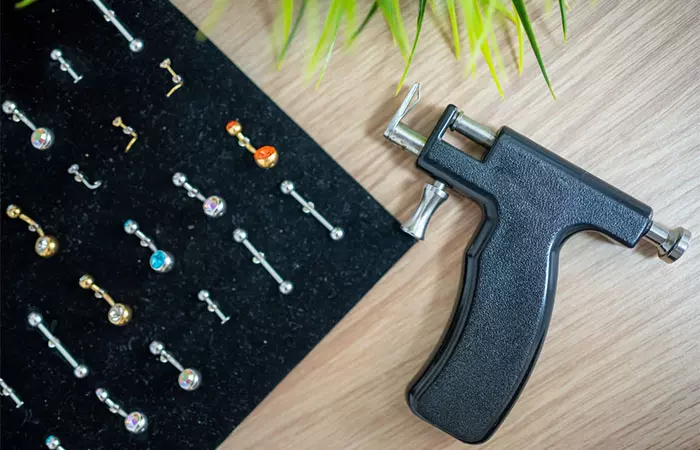
Before piercing your frenulum, the piercer is likely to check if the piercing is possible for you. The piercer will check the thickness of the tissue to ensure the needle can pass through it without any complications. A thin tongue web has a high chance of tearing after the piercing. In such a case, the piercer may advise you against getting the piercing or outright refuse to do it if they find this likely in your case.
On the other hand, if you are good to move ahead, you need to select the initial piercing jewelry. Before getting the piercing, you will have to thoroughly rinse your mouth. The piercer will pass a sterilized hollow needle through the webbing to make a piercing and affix the jewelry.
The overall procedure should take around 30 minutes. The piercing process itself does not take much time but checking the tongue anatomy, jewelry selection, and filling out the details may require you to invest some time.
 Did you know?
Did you know?With an experienced piercer and proper piercing technique, the pain may be under control. However, it may differ for each individual. Keep reading to learn more about the pain level of this piercing.
Pain Level Of A Tongue Web Piercing
Your tongue web contains fewer nerve endings compared to other body piercing sites (1). It hurts relatively less than facial and cartilage piercings, and its pain intensity falls at 3 on a scale of 10. However, it may not be the same for every person. The pain one experiences during the piercing depends largely on the pain tolerance of the person, the piercer’s experience and technique, and the anatomy of your tongue.
Sarah, a blogger, shared her experience of getting tongue frenulum piercings. She wrote, “So, the piercing itself was a piece of cake. It was a dull ache and then got warm and began throbbing – there was no sting or sharp prick feeling. The problem was that my tongue did not want to accept the jewelry and the piercer could not thread it through properly. He kept trying, but the longer I strained my tongue and mouth with a needle through the bottom of it, the more pain I was in (i).” She further explained, “The bottom of my mouth swelled and I had a little bit of a lisp but I just kept rinsing with the mouthwash I was given and assumed it was normal. (I stupidly ignored the instructions to avoid spicy food for the first week. Bad, BAD idea.) After two or three days, it was worse to the point that my entire jaw and neck hurt so badly I could barely talk.”
The initial pain of the piercing is comparatively less than the discomfort one might experience during the healing process. But it can be alleviated if you let your piercing heal properly. In the following section, let us discuss what the healing period looks like for this type of piercing.
Healing Time For A Tongue Web Piercing
usually takes less time compared to other body piercings, and so does a tongue web piercing. The healing time is usually short, around 4-8 weeks. You may experience swelling a day or two after the piercing. To accommodate the swelling, your piercer will fix you with long jewelry in the beginning and change it for a shorter one once the swelling subsides. This will ensure the jewelry does not get embedded into the skin. You may also notice a whitish discharge and feel slightly uncomfortable with the presence of a new object under the tongue, but you will get accustomed to it with time. However, it is important to note that the healing process differs for each individual.
Healing duration largely depends on the aftercare measures one follows. Next, we discuss some tips to care for your oral web piercing.
Aftercare Tips For A Tongue Web Piercing
If you are someone who does not have a regular oral care routine, then you should rethink your decision of getting not only a lingual frenulum piercing but any oral piercing for that matter. People with fresh oral piercings need to keep their mouths clean at all times to decrease the risk of infection. The aftercare for tongue web piercing can be an important deciding factor for how quickly and properly you recover. Here are a few tips to care for your new piercing:
- Avoid smoking as it slows down the body’s natural process of healing (2).
- Do not play with the piercing as it can cause irritation and aggravate the piercing hole.
- Clean your hands thoroughly before touching the piercing to avoid exposing it to harmful germs (3).
- Do not drink alcohol or eat spicy, hot, sticky, acidic, or hard-to-chew foods during the first few days as they can irritate the piercing and increase the swelling.
- Use a soft-bristled toothbrush and floss your teeth carefully to avoid snagging on jewelry.
 Quick Tip
Quick TipAlong with the above-mentioned aftercare practices, cleaning your tongue web piercing helps promote the recovery process. Keep reading to learn more.
How To Clean A Tongue Web Piercing
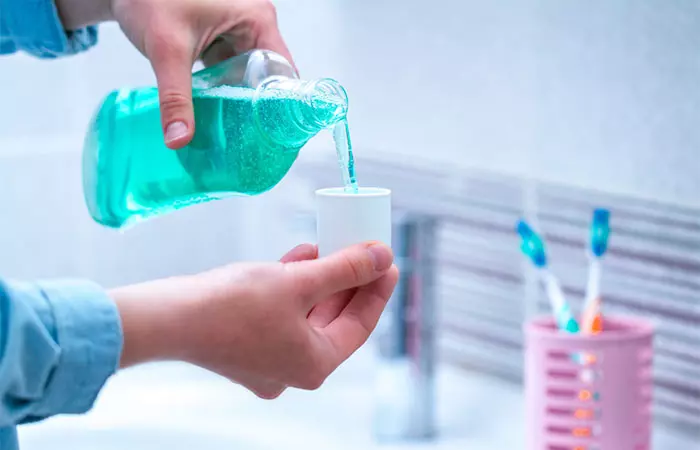
While observing all the necessary precautions for proper healing, you must also keep your piercing clean. Cleaning the piercing ensures there is no growth of harmful bacteria at the piercing site and decreases the risk of infection (4). You can rinse your mouth after every meal with an antiseptic, non-alcoholic mouthwash to avoid food particles from getting stuck in the healing fistula. As an alternative, you can gargle your mouth twice a day with a saline solution or a homemade sea salt solution to clean the piercing (5). We have provided some simple steps you can follow to make it below.
What You Need
- Water
- Sea salt
- Cup
Procedure
- Boil tap water for 5 minutes and add ¼ teaspoon sea salt to it.
- Transfer the salt water to a heat-resistant cup and let the mixture cool down to room temperature.
- Take a mouthful and swish it in your mouth for at least 30 seconds.
- Do it until you have used up all the water in the cup.
- Repeat it twice a day.
Like every other body piercing, this one also has its own advantages and disadvantages. To find out what they are, check out the following section.
Pros And Cons Of A Tongue Web Piercing
The delicate placement of tongue web piercing makes it both a boon and a bane. Some of the pros and cons of the oral frenulum piercing are listed below.
Pros
- It has a unique location.
- You can easily hide it and flaunt it only if you want to.
- The piercing allows you to adorn many types of jewelry.
- It hurts less compared to other body piercings (1).
Cons
- The piercing may get infected, and you may experience swelling and pain along with a discharge of blood and pus.
- The presence of jewelry under the tongue may cause discomfort and pain as it may rub on the underside of the tongue and floor of the mouth.
- Unlike body piercings, the thinness of the tissue and the frequent movement of the tongue increase the risk of rejection in tongue web piercing. This may lead to the development of scar tissue.
- Due to the location of the piercing, constant pressure is exerted on it. This may cause the piercing to migrate or the hole to stretch.
- It is a difficult area to grip and thread jewelry, causing a higher risk of failed piercings and difficult jewelry changes.
- This may also lead to a tear in the frenulum.
- The type of jewelry you pair with your piercing will help prevent tugging and decrease the healing period. Find some jewelry suggestions in the next subhead.
Jewelry And Material For A Tongue Web Piercing
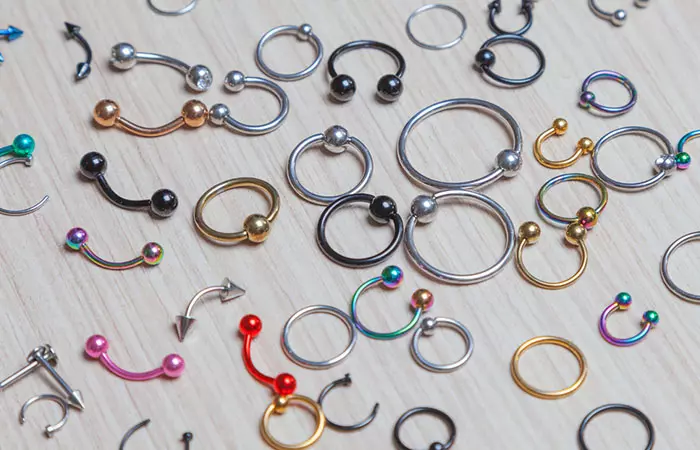
The tongue web piercing allows you to experiment with different types of jewelry. Some of them are listed below.
Barbell: Carved or circular barbells sit comfortably against the floor of the mouth and have beaded ends. A curved barbell is the best for new oral web piercings.
- Straight Bar: It has two beaded ends and a straight rod. You unscrew a bead, push the rod from one side, and screw the bead back on.
- Beaded Studs: They are almost similar to straight bars with the only difference being that they have a comparatively thinner rod. You cannot use studs with flat discs at the back as they will dig into your tongue.
- Captive Bead Ring: They go around the piercing and sit on your mouth floor. If you have a new piercing, avoid going for these as your initial jewelry as they move around a lot, which can irritate the piercing.
When choosing jewelry for a tongue web piercing, avoid materials that can trigger allergic reactions or cause irritation. For example, nickel is a common allergen that can lead to redness, itching, and even painful swelling. You can talk to the piercer and decide on the size of the jewelry accordingly. Surgical stainless steel and implant-grade titanium are the safest jewelry metal options. They are lightweight, hypoallergenic, do not hold bacteria, and help reduce swelling (6).
Infographic: Pros & Cons Of Tongue Web Piercings And Aftercare Tips
Tongue web piercings sit just beneath the tongue and above the floor of the mouth. They are a bold and unique way to express your style. If you are considering this piercing, it is important to weigh its pros and cons. You should also have an idea of the aftercare tips you need to follow for effective healing. This infographic covers all of these things. Scroll down to check it out!
Illustration: StyleCraze Design Team
A tongue web piercing is a delicate perforation made under the tongue. It is visible to others only when you choose to show it. This area does not have many nerve endings, so it does not hurt much and heals relatively quickly than other types of piercings. However, you need to follow proper aftercare practices to ensure the piercing does not get infected or cause dental damage. Rinse your mouth daily with a non-alcoholic mouthwash and salt solution to keep the piercing healthy and prevent food particles from sticking to it. All in all, this comprehensive guide to tongue web piercings equips you with the necessary information to decide whether it is for you.
Frequently Asked Questions
What Can Happen If Proper Aftercare Is Not Followed?
Skipping aftercare can lead to problems like infections, swelling, and pain. It may also slow down the healing process or cause scarring. In some cases, the piercing can even shift or get rejected.
Can you kiss after getting a tongue web piercing?
You should try to avoid kissing or engaging in intimate activities until the swelling goes down and your piercing heals. The swelling may subside in around 3 days. However, the wound remains open for weeks. It is important to note that kissing with an open wound can cause transmission of HIV and Hepatitis C.
How do you eat with a tongue frenulum piercing?
During the first few weeks, you should eat soft foods, such as yogurt, mashed potatoes, pudding, ripe bananas, etc. This will not put extra pressure on your piercing and allow you to relax your mouth.
Can I change the jewelry in my tongue web piercing during the healing process?
It is advised to wait at least 12 weeks before changing your tongue web piercing jewelry. Doing so during the healing process may increase the risk of developing an infected tongue piercing, which may further delay the healing process.
Can I use alcohol or hydrogen peroxide to clean my tongue web piercing?
You should not use alcohol or hydrogen peroxide to clean new oral web piercings as they may irritate the piercing.
Tongue web piercings may be tempting, but they have their merits and demerits. You need to have a comprehensive understanding of the piercing before making a decision. Click on the play button to learn them!
Personal Experience: Source
StyleCraze's articles are interwoven with authentic personal narratives that provide depth and resonance to our content. Below are the sources of the personal accounts referenced in this article.
(i) My Tongue Webbing (Frenulum) Piercing Experiencehttps://thebiggersthebetter.com/2015/04/28/my-tongue-webbing-frenulum-piercing-experience/
References
Articles on StyleCraze are backed by verified information from peer-reviewed and academic research papers, reputed organizations, research institutions, and medical associations to ensure accuracy and relevance. Read our editorial policy to learn more.
- Anatomy and variations of the lingual frenum and sublingual surface
https://link.springer.com/chapter/10.1007/978-3-319-97961-8_15 - Smoking and wound healing
https://pubmed.ncbi.nlm.nih.gov/1323208/ - Caring for new piercings
https://www.aad.org/public/everyday-care/skin-care-basics/tattoos/caring-for-pierced-ears - Bacterial Infections of the oral mucosa
https://www.ncbi.nlm.nih.gov/books/NBK574500/ - Suggested aftercare for oral piercings
https://safepiercing.org/oral-aftercare/ - Jewelry for initial piercings
https://safepiercing.org/jewelry-for-initial-piercings/
Read full bio of Eve Phillips
Read full bio of Sangita Goel
Read full bio of Subhrojyoti Mukherjee
Read full bio of Aparna Harry







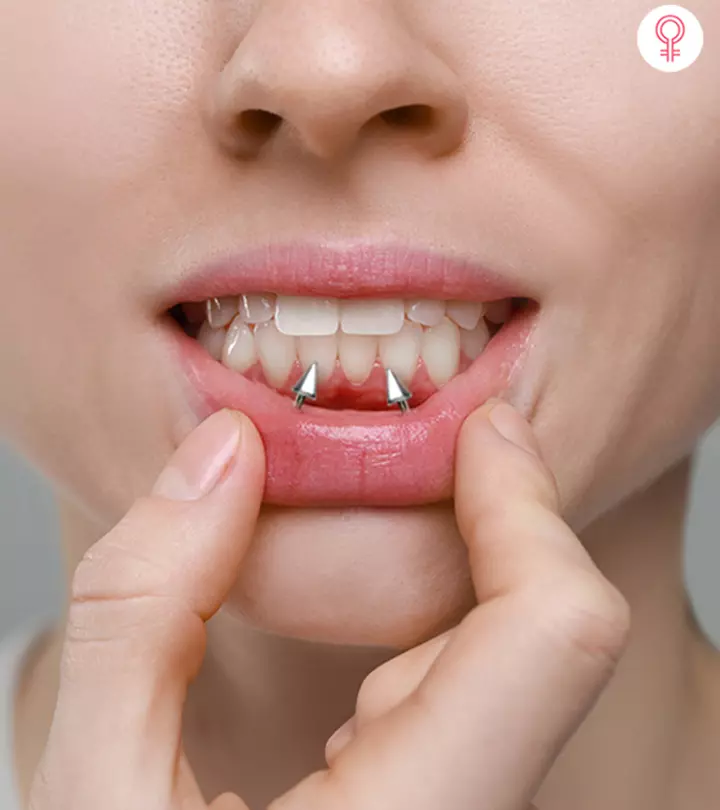

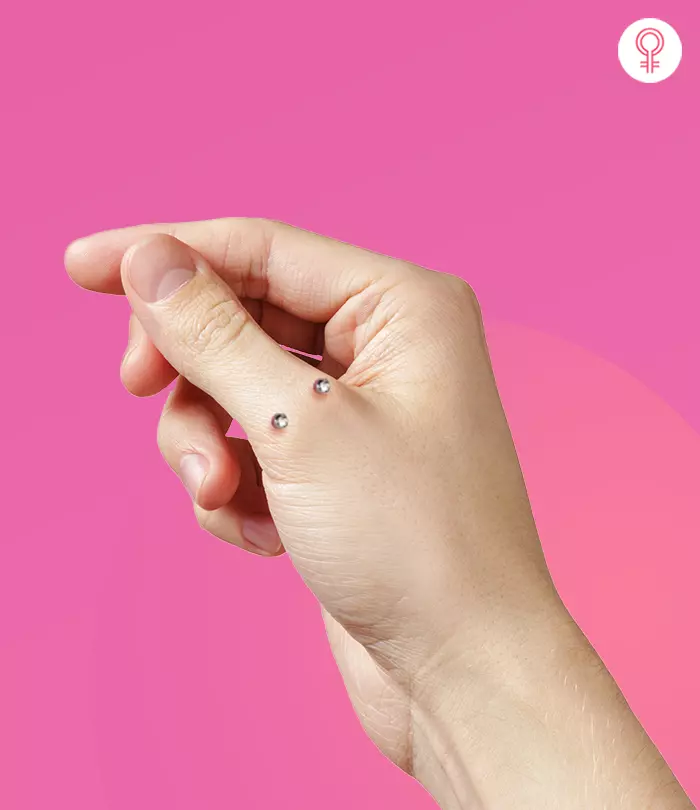

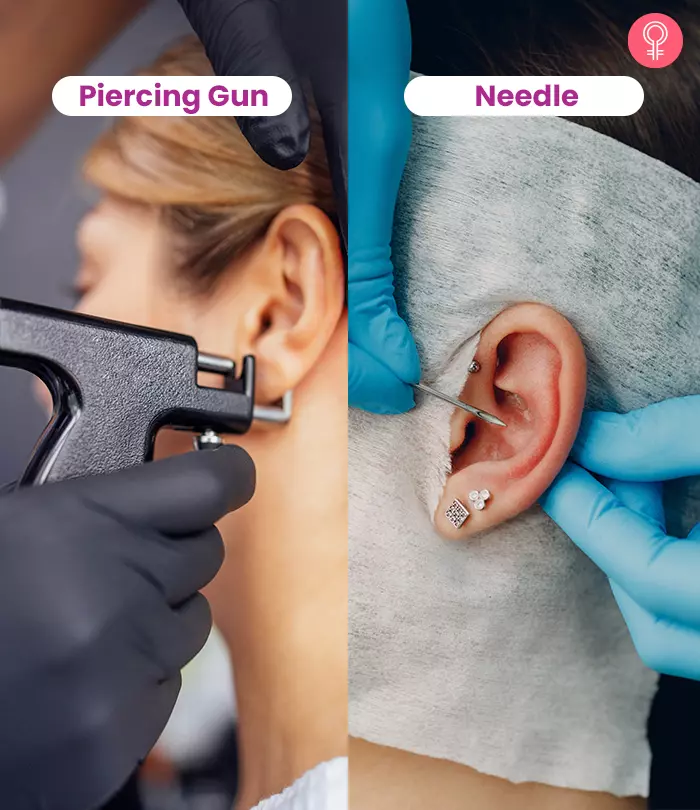









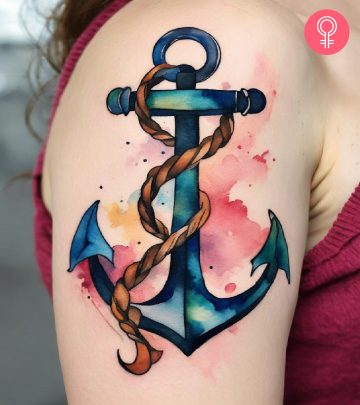





Community Experiences
Join the conversation and become a part of our empowering community! Share your stories, experiences, and insights to connect with other beauty, lifestyle, and health enthusiasts.